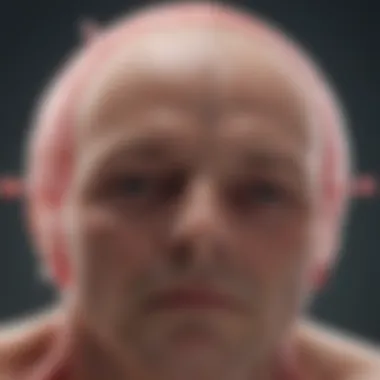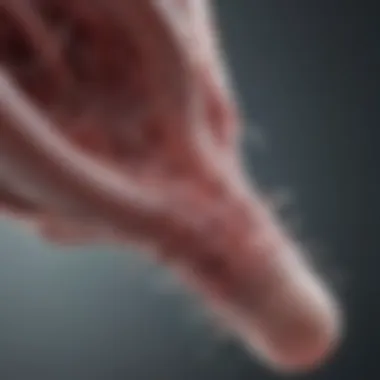Exploring the Complexities of Tissue Transplantation


Intro
Tissue transplantation is a critical area in modern medicine. It involves the transfer of cells, tissues, or organs to replace or restore function in a recipient. The need for transplantation arises from various medical conditions, such as injuries, congenital anomalies, or diseases that impair normal function. Understanding the dynamics of this field provides insight into the evolving landscape of medical practices and the ethical frameworks that underpin them.
Research Overview
Summary of Key Findings
Recent advancements in tissue transplantation have revealed several key findings. Techniques such as 3D bioprinting and stem cell therapy are becoming more prevalent. They offer innovative solutions to replenish damaged or diseased tissues. Increased understanding of immunology also aids in enhancing graft acceptance, reducing the risk of transplant rejection. Research papers frequently discuss not just the biological aspects, but also the socio-economic implications that affect patient access to transplants.
Relevance to Current Scientific Discussions
This topic is at the forefront of biomedical research. Discussions around ethical issues, like consent and organ donation policies, have intensified. The integration of artificial intelligence in matching donors to recipients is also gaining traction. These topics are not only scientific but also societal, making them relevant to policymakers, ethicists, and healthcare providers.
Methodology
Research Design and Approach
Research in this field often employs a mixed-methods approach. Quantitative studies gauge outcomes such as graft survival rates. Qualitative research explores patient experiences and insights from healthcare professionals. This design ensures a comprehensive understanding of both statistical data and personal narratives, enriching the overall analysis.
Data Collection and Analysis Techniques
Data collection methods vary widely. Surveys and interviews add depth to the quantitative data. Statistical software is used for analyzing graft performance, which can also include long-term follow-up studies. This combination enhances the reliability of findings and fosters informed discussions regarding future advancements.
"The evolution of tissue transplantation is not just about medical innovation, but also about addressing complex ethical and logistical challenges."
The End
As the landscape of tissue transplantation continues to evolve, it is crucial to stay informed about the latest research developments and the ethical considerations they entail. This comprehensive guide serves as a foundation for deeper exploration into the multifaceted dynamics of tissue transplantation.
Foreword to Tissue Transplantation
Tissue transplantation is a pivotal area in modern medicine that bridges surgical practice and biological science. The act of transplanting tissues involves replacing damaged or diseased tissues with healthy ones from a donor, enhancing the quality and longevity of a person’s life. Understanding this topic not only sheds light on the techniques and procedures involved but also raises awareness about the ethical and logistical challenges faced in the field. This article delves into the various aspects of tissue transplantation, serving as a comprehensive guide for students, researchers, educators, and medical professionals.
Definition and Scope
Tissue transplantation refers to the process of transferring biological tissues from one individual to another. These tissues can be taken from living or deceased donors. The scope of tissue transplantation extends to several specific types, including organs, skin, bone, and blood vessels. Each of these categories has unique applications and considerations. For instance, skin grafts are commonly used to treat severe burns or skin loss, while organ transplants focus more on critical functions like heart or kidney replacement.
The definition of tissue transplantation also encompasses the immune response that occurs in the recipient's body. This immune response plays a crucial role in the acceptance or rejection of the transplanted tissue, making it essential to tailor donor selection and postoperative care to enhance outcomes.
Historical Overview
The history of tissue transplantation dates back several centuries, with significant milestones that highlight its evolution. The first successful organ transplant, in 1954, involved the kidney transplantation between identical twins performed by Dr. Joseph Murray. This groundbreaking operation laid the foundation for modern transplant immunology and surgical techniques.
Over the years, advancements in medical science, such as the discovery of immunosuppressive drugs, have vastly improved transplant success rates. The development of tissue banking and organ procurement organizations in the late 20th century facilitated the sharing of organs and tissues, addressing the growing need for transplants.
In recent times, breakthroughs in stem cell research and bioengineering have opened new avenues for regenerative medicine, pushing the boundaries of what is possible in tissue transplantation. The journey of tissue transplantation reflects an ongoing commitment to solving medical challenges and improving patient outcomes.
Types of Tissue Transplants
The exploration of tissue transplantation would be incomplete without understanding the various types of transplants available. Each type serves unique purposes, comes with distinct advantages, and poses its own set of considerations. Grasping these differences is essential for healthcare practitioners and researchers engaged in this field.
Autografts
Autografts refer to transplants where tissue is taken from one part of a patient’s body and implanted in another part. This method is valued for its compatibility, as the tissue is not seen as foreign by the immune system. Common examples include skin grafts used in burn victims or bone grafts in orthopedic surgeries. The biggest benefit of autografts lies in the lower risk of rejection and infection since the source and recipient are the same.
However, there are limitations. The area from which the tissue is extracted can face complications, such as increased healing time and additional trauma. Careful consideration is necessary to ensure that the donor site does not suffer significant negative impacts.
Allografts
Allografts involve the transplantation of tissue from one individual to another of the same species. This type is commonly utilized in situations where autografts are not viable, such as in organ transplantation or in cases where significant amounts of tissue are required. Allografts can come from living donors or deceased donors.


While allografts expand the availability of tissue, they carry higher risks than autografts. The primary concern is the immune response. The recipient's body may recognize the transplanted tissue as foreign and initiate a rejection process. Consequently, patients receiving allografts typically need to undergo immunosuppressive therapy, which can heighten risks of infections and other complications.
Xenografts
Xenografts occur when tissues are transplanted between different species. Commonly used xenografts stem from animal tissues, such as pig heart valves for human use. They can serve as a valuable option in circumstances where human tissue is unavailable. The key advantage lies in the accessibility of donor materials, especially in urgent medical needs.
Similar to allografts, xenografts also carry risks of rejection. Additionally, there are concerns regarding the transmission of animal diseases to humans. The regulatory landscape surrounding xenografts is stringent, requiring thorough evaluation and safety measures to mitigate risks.
Composite Tissue Allotransplantation
Composite tissue allotransplantation is a recent advancement focusing on transplants that involve multiple types of tissues, such as skin, muscle, and bone, all at once. This is often employed in reconstructive surgery, for example, facial transplantation after traumatic injuries.
The significance of this method lies in its ability to restore both function and aesthetics, allowing for better rehabilitation. However, the complexity of such transplants poses unique challenges. The coordination of healing between different tissue types demands meticulous postoperative management, and there is a heightened risk of immunological complications that require sustained immunosuppressive therapy.
"Understanding the various types of tissue transplants is crucial for optimizing patient outcomes and navigating the complexities associated with each procedure."
Through these categories, medical professionals can assess the most suitable type of tissue transplant for their patients, factoring in the benefits, risks, and specific clinical contexts. It is vital to stay informed about ongoing developments in this field, as advancements continue to shape effective practices in tissue transplantation.
The Process of Tissue Transplantation
The process of tissue transplantation is a critical aspect of modern medicine. It encompasses various steps that ensure the successful transfer of tissues from a donor to a recipient. Understanding these processes is vital for improving outcomes and enhancing patient safety. Each stage is interconnected and requires careful consideration to minimize complications and maximize benefits.
Donor Selection Criteria
Selecting an appropriate donor is one of the most significant steps in tissue transplantation. This phase involves strict criteria to ensure that the donor's tissues are viable and compatible. Factors such as medical history, age, and overall health are taken into account. The goal is to minimize the risk of rejection and other complications.
Some key considerations in donor selection include:
- Medical History: History of diseases or conditions that could affect tissue viability.
- Age: Younger donors often provide tissues that are healthier and more resilient.
- Infection Screening: Ensuring the absence of infectious diseases is crucial for the recipient's safety.
Ultimately, a thorough evaluation of these factors enhances the chances of a successful transplant.
Harvesting Techniques
Harvesting techniques refer to the methods used to collect tissues from donors. The choice of technique can greatly influence the quality of the harvested tissue. Various surgical methods are employed, depending on the type of tissue to be transplanted.
Among commonly used techniques are:
- Minimally Invasive Surgery: Reduces recovery time and complications.
- Open Surgical Methods: Sometimes necessary for larger tissue collections, despite a longer recovery period.
Adopting the appropriate harvesting technique ensures that tissues remain intact and functional, which is essential for their success post-transplantation.
Transplant Procedure
The actual transplant procedure is a complex operation that necessitates precision and expertise. Surgeons must adhere to rigorous protocols to place the harvested tissues into the recipient. The technique can vary based on the type of transplant—whether it is an autograft, allograft, or xenograft.
Important steps in the transplant procedure include:
- Anesthesia Administration: Ensuring the recipient is comfortable and pain-free during the surgery.
- Incision Creation: Making an incision at the transplant site.
- Tissue Placement: The harvested tissue is placed with care to ensure proper integration.
- Closing Incisions: Efficiently closing the surgical site to promote healing.
This phase requires teamwork among various medical professionals, including surgeons, nurses, and anesthetists, to ensure a successful operation.
Postoperative Care
Postoperative care is essential in the transplantation process. It plays a crucial role in recovery and the long-term success of the transplant. Medical teams must carefully monitor the recipient for signs of complications or rejection.
Key aspects of postoperative care include:
- Monitoring Vital Signs: Regular checks to ensure stability.
- Medication Administration: Use of immunosuppressants to prevent rejection.
- Physical Rehabilitation: Helping the recipient regain strength and mobility.
Effective postoperative care can significantly impact the overall success of the transplantation, providing patients with improved outcomes and quality of life.


"Proper management during the entire process, from donor selection to postoperative care, is essential for successful tissue transplantation."
Immunology of Transplantation
The study of immunology in transplantation is essential to understand how the body reacts to transplanted tissues. An essential aspect of tissue transplantation involves the immune response, which can significantly affect the success of the procedure. Both surgeons and transplant coordinators need to grasp the principles of immunology to optimize patient outcomes.
Understanding Immune Response
The immune system plays a critical role in determining the fate of a transplanted tissue. When a foreign tissue is introduced to the body, the immune system recognizes it as non-self. This recognition triggers various immune responses. There are two main types of immune response:
- Innate immunity: This is the body’s initial, non-specific response to a foreign object. It includes physical barriers like skin, and internal responses such as inflammation.
- Adaptive immunity: This response is more sophisticated and involves specific immune cells that remember past invasions. T cells and B cells are crucial elements of this response.
Understanding these responses helps medical professionals tailor approaches to minimize complications during and after transplantation. The positive side is that it can lead to improved techniques in matching donors with recipients.
Rejection Mechanisms
Rejection occurs when the body mounts an immune response against the transplanted tissue. There are primarily three types of rejection:
- Hyperacute rejection: This happens within minutes of transplantation due to pre-existing antibodies against the donor tissue. It is often deadly and irreversible.
- Acute rejection: This type usually occurs within weeks to months post-transplant. T cells recognize the transplanted tissue and attack it.
- Chronic rejection: This type is a gradual response that can occur over years. It leads to long-term deterioration of the transplant function.
Effective management of rejection mechanisms is integral to the success of tissue transplantation.
Recognizing these rejection types allows medical teams to develop monitoring strategies and intervene at key points, enhancing the longevity of transplants.
Immunosuppressive Therapies
To prevent or manage rejection, immunosuppressive therapies are employed. These treatments inhibit the immune system's response, allowing the transplanted tissue to coexist without being attacked. Common therapies include:
- Calcineurin inhibitors: Such as cyclosporine and tacrolimus.
- Antiproliferative agents: Such as azathioprine or mycophenolate mofetil.
- Corticosteroids: Used to reduce inflammation in the body.
While these therapies are crucial for transplantation success, they also increase the risk of infection and other complications. Therefore, balancing the immunosuppressive treatment is key to promoting healthy recovery while minimizing side effects.
Current Challenges in Tissue Transplantation
Tissue transplantation represents a remarkable advancement in modern medicine, providing options for patients facing serious health issues. Despite its potential, several challenges persist, hindering the success and accessibility of transplants. Understanding these challenges is crucial for healthcare professionals and researchers. Addressing these issues will enhance patient care, improve outcomes, and make transplantation a more viable option for those in need.
Shortage of Donors
One of the most pressing challenges in tissue transplantation is the shortage of donors. The demand for organs and tissues far exceeds the available supply. This shortage can lead to waiting lists that stretch for years, resulting in the deterioration of patients' conditions. Donor organs are often allocated based on strict criteria, which can further limit availability.
Efforts to increase donor numbers include public education campaigns on the importance of organ donation and the implementation of opt-out policies in certain regions. According to the American Transplant Foundation, over 100,000 people are currently awaiting organ transplants in the United States alone.
- Ways to tackle donor shortage:
- Increase public awareness
- Improve donor registration
- Explore living donation options
Despite these efforts, numerous barriers remain, including cultural beliefs, misinformation about organ donation, and a lack of trust in the healthcare system.
Transplant Complications
Transplant complications present another significant hurdle in the field. These complications can arise during the procedure or within the postoperative phase. Common transplant complications include:
- Rejection: The body’s immune system may recognize the new tissue as foreign and attack it.
- Infection: Immunosuppressive therapies used to prevent rejection can increase susceptibility to infections.
- Graft-versus-host disease (GVHD): In cases of allogenic transplants, donor immune cells may attack the recipient's tissues.
Managing complications requires rigorous monitoring and may necessitate additional interventions, which could further complicate a patient's recovery. Ongoing research focuses on improving immunosuppressive strategies and monitoring protocols to enhance patient outcomes.
Ethical Dilemmas
Ethical dilemmas are an inherent aspect of tissue transplantation. The decision to donate tissues or organs involves profound personal and ethical considerations. Key ethical issues include:
- Informed consent: Ensuring that donors and recipients fully understand the implications of transplantation.
- Allocation fairness: Deciding how to distribute scarce resources to those in need, which raises questions about equity and justice.
- Commercialization of organ donation: The potential dangers of treating organ supply as a commodity can lead to exploitation and unethical practices.


Discussions around these dilemmas require multidisciplinary input from ethicists, medical professionals, and policymakers. This collaborative approach is crucial for cultivating a fair and just framework for tissue transplantation.
"The challenges of tissue transplantation are as diverse as the patients affected by them. Addressing these issues through collaboration, innovation, and ethical considerations remains paramount."
Recognizing these dilemmas can lead to better policies and practices that respect patient rights while maximizing the benefits of transplantation. Addressing these complex challenges is essential not only for enhancing tissue transplantation success but also for ensuring a more equitable healthcare system.
Future Directions in Tissue Transplantation
The landscape of tissue transplantation is on the brink of significant transformation. Advancements in various fields promise to enhance the effectiveness and scope of transplantation procedures. This section examines the future directions that could revolutionize how tissue transplantation is conducted, focusing on key areas such as stem cell research, bioengineering innovations, and regenerative medicine approaches. Understanding these dynamics is critical for students, researchers, and professionals who are engaged in transplantation science. The potential benefits include improved patient outcomes, reduced transplant rejection rates, and expansion of available tissues for transplantation.
Advancements in Stem Cell Research
Stem cell research stands at the forefront of tissue transplantation advancements. The unique properties of stem cells allow them to differentiate into various tissue types, thus offering a renewable source for transplants. Research is increasingly revealing the possibilities of using induced pluripotent stem cells (iPSCs) which can be derived from a patient's own cells. This method minimizes the risk of rejection and eliminates the ethical concerns associated with embryonic stem cells.
In addition, developments in differentiating stem cells into specific tissue forms, such as neurons or cardiac cells, are highly promising. This technology could provide an avenue for generating personalized tissues, catering directly to individual patient needs. Ongoing studies are investigating the efficacy of these differentiated cells in preclinical models, which could accelerate their transition to clinical practice.
Innovations in Bioengineering
Bioengineering plays a key role in enhancing tissue transplantation. This field combines engineering principles with biological knowledge to create synthetic materials that can mimic the properties of human tissues. Tissue engineering is making strides in developing scaffolds that support cell growth and function.
One promising approach is 3D bioprinting, where layers of cells and biomaterials are precisely deposited to create complex tissue structures. This technology has the potential to produce organs on demand, addressing the critical shortage of available donor organs.
Moreover, innovations in implantable biosensors are being explored. These sensors can monitor the condition of transplanted tissues in real time, providing crucial data that can guide medical interventions post-transplant.
Regenerative Medicine Approaches
Regenerative medicine is poised to reshape the field of tissue transplantation further. This discipline focuses on harnessing the body's innate healing processes to repair or replace damaged tissues. Techniques such as gene therapy, which modifies or introduces genes to enhance tissue recovery, show substantial promise.
One application includes using growth factors to stimulate tissue regeneration. Researchers are exploring how these factors can be applied after transplantation to improve graft survival and integration. Additionally, the integration of regenerative medicine with transplantation could lead to hybrid approaches that not only transplant tissue but also promote its long-term health.
"Future advancements may lead to a paradigm shift in transplantation, emphasizing regeneration over replacement."
Impact of Tissue Transplantation on Society
Tissue transplantation holds significant importance in modern medicine. Its influence extends beyond individual patient care, shaping societal perspectives on health, ethics, and scientific progress. Recognizing the impact of tissue transplantation on society informs discussions about the benefits it provides and the considerations it raises.
Improving Quality of Life
Tissue transplantation directly enhances the quality of life for many patients. Successful transplants can restore function and alleviate suffering associated with various medical conditions. For example, patients receiving skin grafts after severe burns experience improved healing and reduced physical discomfort. Similarly, organ transplants can mean the difference between a confined life and one filled with possibilities for those suffering from organ failure.
By integrating the latest medical advancements, the field of transplantation has evolved to address not only the immediate needs of patients but also their long-term health prospects. Patients can return to their daily activities, including work and recreation, contributing positively to their communities.
Moreover, the psychological benefits are notable. Many recipients report emotional well-being, stemming from the regained ability to engage in life fully. Improved quality of life also brings ripple effects to families and caregivers, as their burdens often lessen with the patient's enhanced health.
Healthcare Economics
The economic implications of tissue transplantation are multifaceted. On one hand, the costs associated with transplantation can be daunting. This includes expenses related to surgery, hospital stays, and ongoing immunosuppressive therapy. However, it is essential to consider the broader economic perspective.
- Cost-Effectiveness: Despite the initial costs, successful transplants can lead to long-term savings in healthcare. Patients who regain health often lower their dependence on medication and reduce the need for recurring medical interventions. This can translate into financial benefits for healthcare systems and society at large.
- Increased Productivity: Healthy individuals contribute to the workforce, enhancing economic output. Many patients become able to work full-time post-transplant, positively affecting their families and local economies.
- Research and Development: Investing in transplantation technologies fosters innovation within the sector. This investment can stimulate economic growth through new job creation in medical and research fields, while also improving patient outcomes.
"The true value of tissue transplantation lies not only in saving lives but also in enhancing the well-being of countless individuals and their communities."
The End
The topic of conclusion is essential as it synthesizes the extensive information presented in this article about tissue transplantation. Understanding this field is vital for various reasons. Firstly, it reinforces the significance of transplantation in modern medicine, showcasing its role in improving patients’ lives. Various transplant types, from autografts to composite tissue allotransplantation, highlight the multifaceted nature of this medical practice.
In these final sections, the reader reflects on the main themes discussed, such as the complex immune response, donor selection, and advancements in the field. This recap helps crystallize the concepts discussed into actionable intelligence, suitable for students, researchers, and practicing professionals seeking to improve their knowledge.
Additionally, the conclusion serves as a platform to emphasize the ethical dimensions that query the very fabric of medical practices—highlighting the balance between innovation and moral responsibilities in transplantation.
Summary of Key Points
- Tissue transplantation significantly enhances quality of life for many individuals.
- Different types of grafts have unique characteristics and implications, relevant in selection for transplantation.
- The donor selection process and harvesting techniques are crucial in ensuring successful transplants.
- Immunological responses pose challenges, making understanding rejection mechanisms pivotal.
- Future advancements in biotechnology and regenerative medicine may reshape the field, leading to better outcomes for patients.
Call for Ongoing Research
There is an urgent need for ongoing research in the field of tissue transplantation. The following areas are particularly significant:
- Innovation in immunosuppressive therapies: As rejection remains a primary hurdle post-transplant, improving current drug regimens or finding new solutions is of utmost importance.
- Ethical frameworks: As technology evolves, so too must our understanding of ethical implications related to donor consent and allocation of scarce resources.
- Biotechnological advancements: Continuous exploration into stem cell research and bioengineering holds potential for breakthroughs that could enhance the methods of transplanting tissues.



